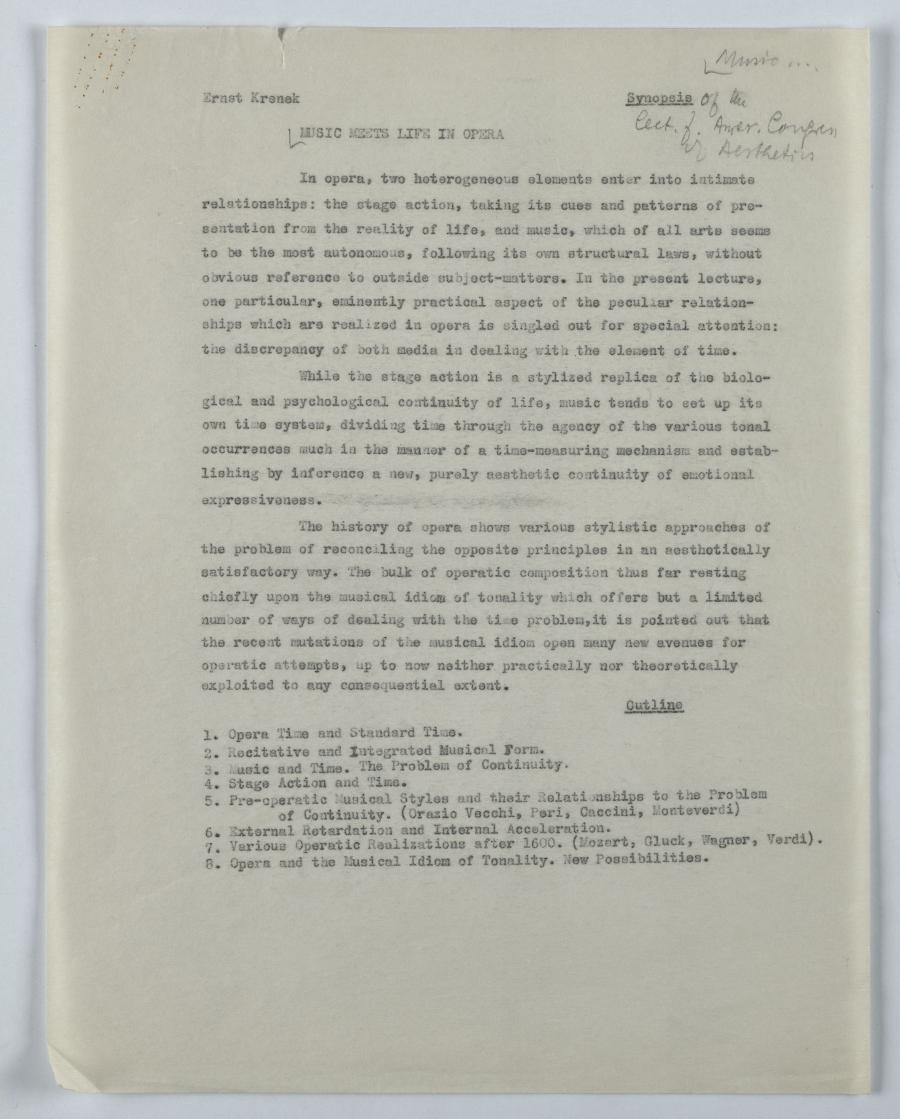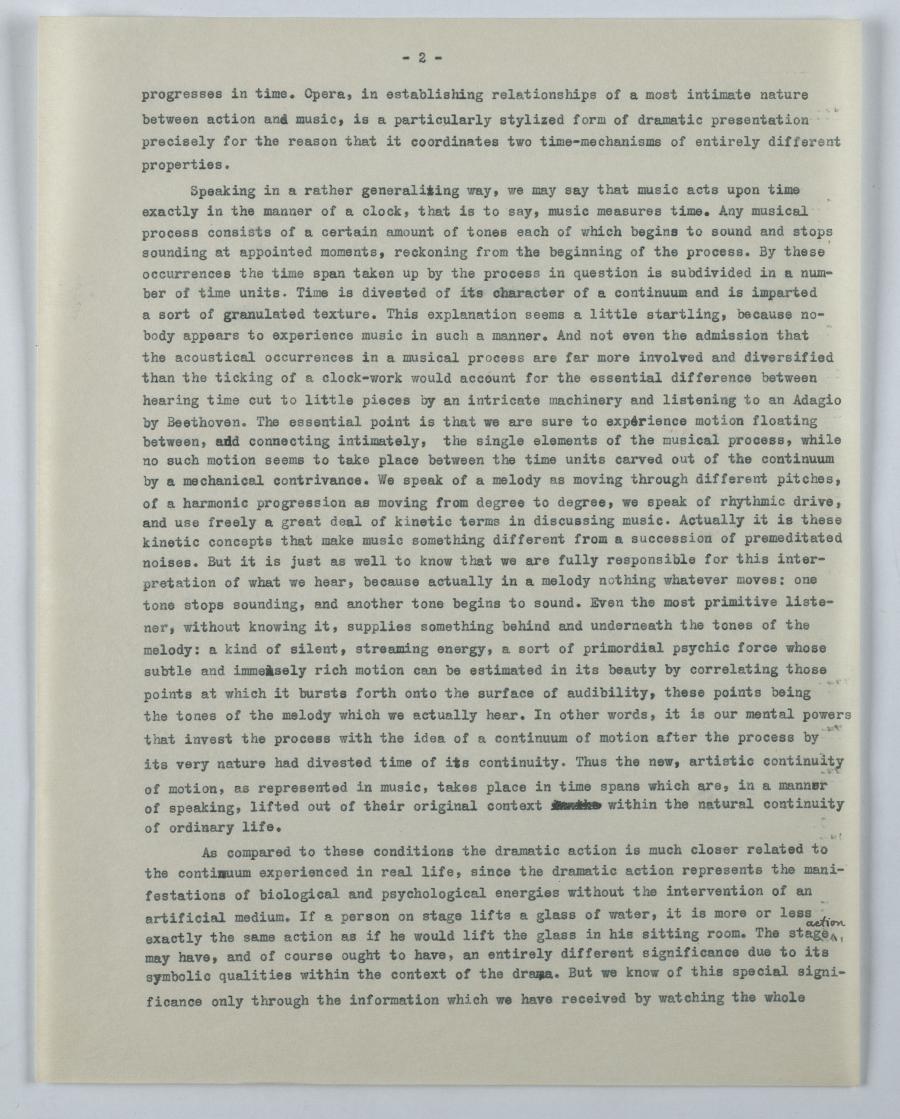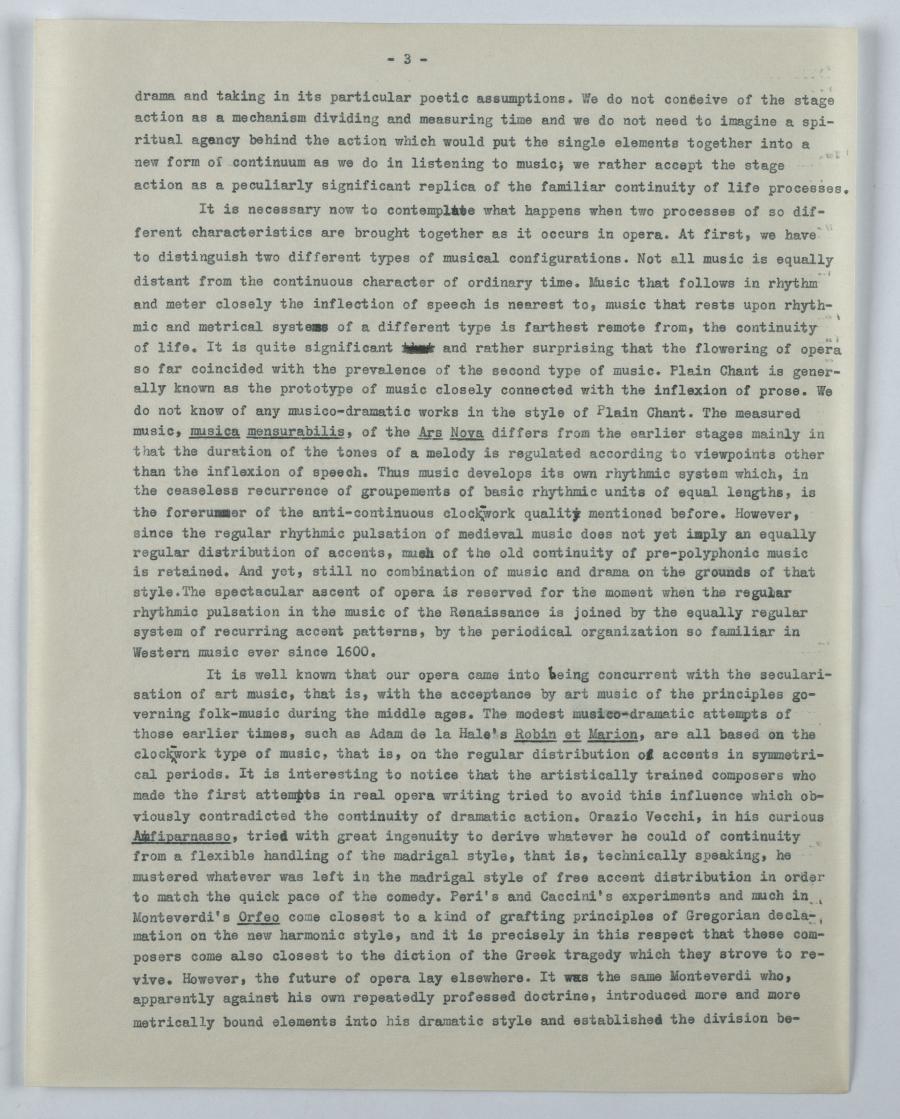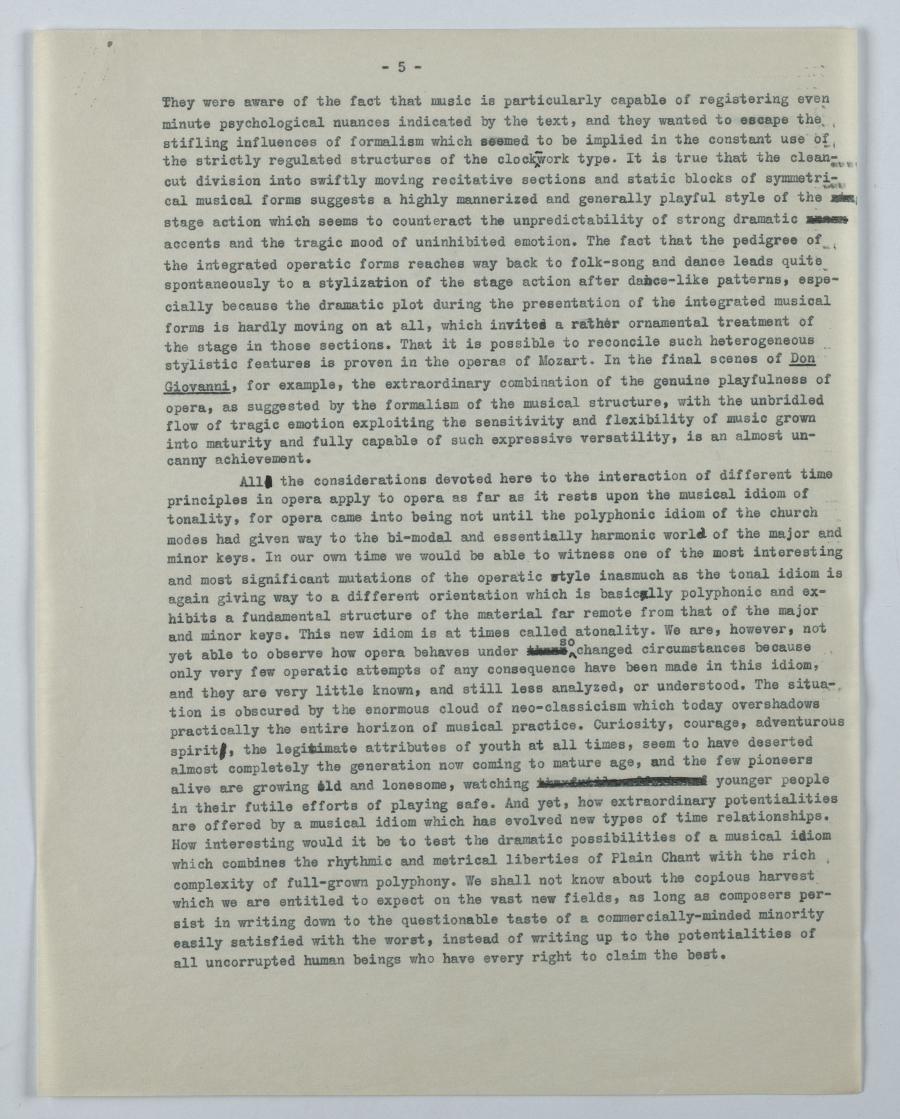Music meets Life in Opera
Abstract
In dieser Ansprache am 2. Amerikanischen Kongress für Ästhetik befasst sich Krenek mit Fragen der Zeit im Musiktheater, insbesondere mit den Differenzen zwischen dem zeitlichen Verlauf von Handlungen in realen Leben und deren Repräsentation auf der Bühne, sei es durch reine Aktion auf der Bühne oder in unterschiedlichen musikalischen Strukturen wie secco Rezitativ oder Arien. Er wirft dabei auch einen kursorischen Blick auf die Geschichte der Oper und schließt mit Überlegungen, wie mit den kompositorischen Mitteln der Neuen Musik noch unausgeschöpfte Möglichkeiten für die Gestaltung von zeitlichen Relationen des Bühnengeschehens durch Musik offen stehen.
Dem Dokument vorangestellt ist eine kurze Zusammenfassung.
Synopsisof the lect. f. Amer. Congress of Aesthetics
In opera, two heterogeneous elements enter into intimate relationships: the stage action, taking its cues and patterns of pre- sentation from the reality of life, and music, which of all arts seems to be the most autonomous, following its own structural laws, without obvious reference to outside subject matters. In the present lecture, one particular, eminently practical aspect of the peculiar relation- ships which are realized in opera is singled out for special attention: the discrepancy of both media in dealing with the element of time.
While the stage action is a stylized replica of the biolo- gical and psychological continuity of life, music tends to set up its own time system, dividing time through the agency of the various tonal occurrences much in the manner of a time measuring mechanism and estab- lishing by inference a new, purely aesthetic continuity of emotional expressiveness.
The history of opera shows various stylistic approaches of the problem of reconciling the opposite principles in an aesthetically satisfactory way. The bulk of operatic composition thus far resting chiefly upon the musical idiom of tonality which offers but a limited number of ways of dealing with the time problem, it is pointed out that the recent mutations of the musical idiom open many new avenues for operatic attempts, up to now neither practically nor theoretically exploited to any consequential extent.
Outline
1. Opera Time and Standard Time.
2. Recitative and Integrated Musical Form.
3. Music and Time. The Problem of Continuity.
4. Stage Action and Time.
5. Pre-operatic Musical Styles and their Relationships to the Problem
of Continuity. (
OperaAddress at the Second American Congress for Aesthetics, Catholic University of America,
Opera is the meeting place of two apparently quite heteregeneous art forms:
on the one hand, the stage action, by subject-matter and method of presentation im-
mediately related to the reality of life - on the other hand, music, most abstract of
arts, a self-sustained system of auditory symbols, in no tangible way related to any
subject matter outside
The manifold aesthetic problems arising from this challenging combination
of elements have been subject to
We know that opera very early developed a tendency towards discriminating sharp- ly between two types of setting the words: the recitative, and the integrated musical form, such as aria, duet, or other kinds of ensemble singing. As far as the time factor is concerned, the recitative approaches most closely the natural speed of the spoken word, so that the action carried on in the recitative sections is hardly slower than it would be without music. In the integrated musical forms, however, action comes frequent- ly to an almost complete standstill that has no parallel in the progress of a spoken play, except in the monologues of the classical tragedy, perhaps.
Discrepancy between the time of ordinary life and the time inherent to the
work of art is very conspicuous in opera; it is, however, Lectures in America, Plays. p. 93
And further: "Then gradually there came the beginning of really realizing the great dif-
ficulty of having my emotion accompany the scene and then moreover I became fairly con-
sciously troubled by the things over which one stumbles over which one stumbled to such
anop. cit., p. 114.
Whether one experiences this state of affairs as a difficulty, or recognizes in it the
source of the peculiar aesthetic values of dramatic performances, it is true at any
rate that the stylization of action necessary in any dramatic presentation, though in
different degrees, depends mainly on the autonomous fashion in which the dramatic action
progresses in time. Opera, in establishing relationships of a most intimate nature between action and music, is a particularly stylized form of dramatic presentation precisely for the reason that it coordinates two time-mechanisms of entirely different properties.
Speaking in a rather generalizing way, we may say that music acts upon time
exactly in the manner of a clock, that is to say, music measures time. Any musical
process consists of a certain amount of tones each of which begins to sound and stops
sounding at appointed moments, reckoning from the beginning of the process. By these
occurrences the time span taken up by the process in question is subdivided in a num-
ber of time units. Time is divested of its character of a continuum and is imparted
a sort of granulated texture. This explanation seems a little startling, because no-
body appears to experience music in such a manner. And not even the admission that
the acoustical occurrences in a musical process are far more involved and diversified
than the ticking of a clock-work would account for the essential difference between
hearing time cut to little pieces by an intricate machinery and listening to an Adagio
by
As compared to these conditions the dramatic action is much closer related to
the continuum experienced in real life, since the dramatic action represents the mani-
festations of biological and psychological energies without the intervention of an
artificial medium. If a person on stage lifts a glass of water, it is more or less
exactly the same action as if he would lift the glass in his sitting room. The
drama and taking in its particular poetic assumptions. We do not conceive of the stage action as a mechanism dividing and measuring time and we do not need to imagine a spi- ritual agency behind the action which would put the single elements together into a new form of continuum as we do in listening to music; we rather accept the stage action as a peculiarly significant replica of the familiar continuity of life processes.
It is necessary now to contemplate what happens when two processes of so dif-
ferent characteristics are brought together as it occurs in opera. At first, we have
to distinguish two different types of musical configurations. Not all music is equally
distant from the continuous character of ordinary time. Music that follows in rhythm
and meter closely the inflection of speech is nearest to, music that rests upon rhyth-
mic and metrical systems of a different type is farthest remote from, the continuity
of life. It is quite significant musica mensurabilis, of the Ars Nova differs from the earlier stages mainly in
that the duration of the tones of a melody is regulated according to viewpoints other
than the inflexion of speech. Thus music develops its own rhythmic system which, in
the ceaseless recurrence of groupements of basic rhythmic units of equal length, is
the forerunner of the anti-continuous clock-work quality mentioned before. However,
since the regular rhythmic pulsation of medieval music does not yet imply an equally
regular distribution of accents, much of the old continuity of pre-polyphonic music
is retained. And yet, still no combination of music and drama on the grounds of that
style. The spectacular ascent of opera is reserved for the moment when the regular
rhythmic pulsation in the music of the Renaissance is joined by the equally regular
system of recurring accent patterns, by the periodical organization so familiar in
Western music ever since 1600.
It is well known that our opera came into being concurrent with the seculari-
sation of art music, that is, with the acceptance by art music of the principles go-
verning folk-music during the middle ages. The modest musico dramatic attempts of
those earlier times, such as Robin et Marion Amfiparnasso, tried with great ingenuity to derive whatever he could of continuity
from a flexible handling of the madrigal style, that is, technically speaking, he
mustered whatever was left in the madrigal style of free accent distribution in order
to match the quick pace of the comedy.
come closest to a kind of grafting principles of Gregorian decla- mation on the new harmonic style, and it is precisely in this respect that these com- posers come also closest to the diction of the Greek tragedy which they strove to re- vive. However, the future of opera lay elsewhere. It was the sameOrfeo
tween recitative and integrated musical form. And we have to admit that the tremen- dous attraction exerted by opera ever since rests not upon the expeditious parts of the music which are best adapted to follow the continuity of the action, but on those sections which are musically most elaborate and bring the action virtually to a stand- still.
Looking more closely into the interrelation between the various types of opera-
tic music, we discover that only the external action is stopped, or slowed down, by
the circumscribed musical structures. During arias, or ensembles, the visible progress
of the dramatic vehicle is interrupted to a great extent, however, the stream of emo-
tion pervading the whole is intensified, which in many cases amounts to an internal
acceleration of the action, setting off its external retardation. The reason is that
the peculiar faculty of music of throwing emotional forces into relief grows in
straight proportion with the amount of freedom granted to music in order to develop
logical structures according to its own, inherent laws. In other words, the most
autonomous, most concentrated and intrinsically coherent musical structure is the
most efficient carrier and the most eloquent messenger of emotional energies. There-
fore it is possible in the musically most fully organized operatic forms, which ap-
pear secco recitative of the
classical opera is to be considered fairly synchronized with the progress of ordi-
nary time. However, ascending gradually to higher organized musical structures, we
arrive at a state of things comparable to those astounding motion pictures which
show an imperceptibly slow process, such as the growth of a tree, in a few minutes,
by projecting in rapid succession a sequence of pictures taken at far distant mo-
ments of the process.
Inspecting the short history of opera, we observe that clear-cut separation
of the varying degrees of internal and external speed was the stylistic ideal of the
18th century, while the early beginnings of opera in the 17th as well as the evolu-
tion of the 19th show a tendency toward assimilating the divergent elements. That
observation is well in keeping with the fact that in the 18th century the clock-work
type of music - regularly pulsating accompaniment, symmetrical periodicity - was
flowering. The romantic doctrine of the 19th century abandoned gradually these musi-
cal features and made music more flexible so that in the late works of
They were aware of the fact that music is particularly capable of registering even
minute psychological nuances indicated by the text, and they wanted to escape the
stifling influences of formalism which seemed to be implied in the constant use of
the strictly regulated structures of the clock-work type. It is true that the clean-
cut division into swiftly moving recitative sections and static blocks of symmetri-
cal musical forms suggests a highly mannerized and generally playful style of the Giovanni, for example, the extraordinary combination of the genuine playfulness of
opera, as suggested by the formalism of the musical structure, with the unbridled
flow of tragic emotion exploiting the sensitivity and flexibility of music grown
into maturity and fully capable of such expressive versatility, is an almost un-
canny achievement.
All





